Simulation Tools
-
- Marine Training Via Simulation: As Real as it Gets Maritime Reporter, Sep 2001 #50
The abandonment of the concept of controlled simulation environment, as per the National Research Council's endorsed simulation classification scheme, would constitute a significant step backwards for the quality and effec- tiveness of maritime training .
Now is the time to re-evaluate the proper role of CBT in training, and, in the process, re-visit training competency and learning proficiency support provid- ed by all simulation technologies Realism, Why Bother?
Here is a perspective regarding realism in simulation. A simulation student was complaining to his company office that the simulator he was working on that day was not very realistic. He went on to say that the ship drove too easily, the visual picture was phony, and that the some of the bridge gear was not real equipment. The fellow from his office told him, "That's why they call it a simulator.
If it were all real, they would have to call it a real-ator." Given that it is not feasible to create real-ators, only simulators, why does the maritime training industry care about simulation realism?
Typically training attempts to prepare a person to apply the acquired training objectives on a real ship, and to tackle real problems in a realistic amount of time, with real consequences.
Thus, if the training program can simulate realistic conditions, the objectives can be offered in a proper context, so that they best prepare the mariners for their real problems. Secondly, the recent training focus provided by the requirements of the Standards of Training and Certification of Watchkeepers (STCW-95), requiring assessed proof of competency during maritime training has required training facilities to take a new look at how tasks and training objectives are assessed and documented during simulation. It is only through control of the simulated environment, and by realistically matching the simulator performance to the training objectives that valid competency assessments may be conducted. From the pragmatic viewpoint, proper use of simulation in training, including the conscientious control of simulation environment, provides the best possible outcome for a given training investment.
Using The Category 1 Simulator in Maritime Training The Category 1 simulator is the Full Mission Ship Simulator (FMSS) that is used by every large maritime training institution across the country. FMSS systems are used for full immersion training with maximum possible control of the simulation environment.
Typically, FMSS systems have complete bridge systems installed in a bridge mock-up, including sound and realistic visuals. This highly controlled environment is designed to provide a dynamic setting for presenting program learning objectives in a realistic shipboard context.
It is most appropriate for use in acquiring proficiency in teamwork, shiphandling and integrated watchstanding tasks. The Category 1 FMSS must be equipped with high fidelity ship and topological modeling, including interactions between all simulated entities within the six-degrees of freedom of ship motions. A simulator that lacks the high fidelity technical ability to replicate discrete ship motions interacting with other vessels and the environment will subsequently lack the ability to support training objectives in areas of ship-toship interaction, squat, control of bank cushion, suction and objectives oriented to the control of finite lateral ship motions associated with docking and tug assist work. Thus, the FMSS must be more than a pretty picture connected to a fully outfitted bridge, equipped with gear as per the Det Norske Veritas (DNV) Class A simulated bridge standard.
It must be able to support the fidelity and accuracy of close maneuvering ship behavior standards in order to be classified as NRC Category 1.
Simulators that lack the modeling fidelity and accuracy, but do have a full bridge environment and at least 240 degrees of visual field of view, are classified as Category 2, Multi-task simulators.
Pragmatically, the training limitation of an FMSS system is that it can provide excessive stimulus and distractions for the mariner to adequately perform the program objective tasks. Additionally, given the variety of options and inputs available to a mariner in a FMSS system, it is difficult to assess the competency of the mariner in using specific bridge systems, as they may be actually using other systems and environmental inputs to accomplish the task. For example, assessment of proficiency in collision avoidance using radar/ARPA is difficult to assess in a FMSS, when the mariner also has access to a visual scene or a bridge team, which they may be relying on for danger bearings and identification, instead of demonstrating proficiency with the radar/ARPA unit.
Thus, the FMSS is tailored for integrated assessments and teamwork performance using complex vessel and environmental models, and is not designed for focused task proficiency training or general watchstanding team training.
Classifying Simulators In 1996 the National Research Council (NRC) published a compilation of expert essays titled, "Simulated Voyages," in which the NRC provided a classification scheme for maritime simulators which was subsequently proposed to the International Maritime Organization (IMO).
NRC, Simulated Voyages, p.39, National Academy Press, 1996.
Category 1: Full Mission. Capable of simulating full visual navigation bridge operations, including capability for advanced maneuvering and pilotage training in restricted waterways.
Category 2: Multi-task. Capable of simulating full visual navigation bridge operations, as in Category 1, but excluding the capability for advanced restricted-water maneuvering.
Category 3: Limited Task. Capable of simulating, for example, an environment for limited (instrument or blind) navigation and collision avoidance.
Category 4: Special Task. Capable of simulating particular bridge instruments, or limited navigation maneuvering scenarios, but with the operator located outside of the environment (e.g. a desktop simulator using computer graphics to simulate a birds-eye view of the operating area).
Multi-Task Simulators The Category 2, Multi-task maritime simulation trainers are designed to provide simulated training environments with accurate bridge equipment and high fidelity visual scenes without the large capital investment required for complex hydrodynamic vessel and topological modeling. The Category 2 trainer is designed to support training objectives for Bridge Resource Management, Team Dimensional Training, watch- keeping tasks, collision avoidance, communications, at-sea, deep-water maneuvering and other training that does not require highly refined ship models. These systems will typically employ simple 3 degree of freedom ship models, with little, if any, differences between the fidelity of the ownship models and the fidelity of the target ship models in the simulation.
These simple models display motions that rotate about the center of gravity, tipping center or turning center, but they do not display transverse motions representing physical displacement of the vessel's center of gravity. Essentially, these simple models can wobble the ship over one point, but they cannot slide the ship laterally away from a position, or bob it up and down as in a squat simulation. Simple three degree of freedom modeling is typically used in CBT simulators as well.
Limited Task Simulator in Maritime Training The NRC Category 3 Limited Task trainer is a simulator designed to support training objectives for specific tasks and competencies, associated with equipment and limited underway operations that do not require a visual scene (blind bridge). The Category 3 simulator is used for radar, Automated Radar Plotting Aid (ARPA), Electronic Chart Display Information System (ECDIS), Automated Information Systems (AIS), Vessel Traffic Systems (VTS) and chartwork/pilotage training. The key differences between the Category 3 Limited Task simulator and the Category 4 Special Task simulation system are that the Category 3 system provides separate interaction between ownships, limited bridge settings and realistic equipment, interactive maritime based communications between vessels and physical separation between bridges, along with guided instruction from a simulation trained instructor.
Category 3 simulators can employ simplistic modeling for the vessels and environment and use simulated bridge equipment rather than real hardware. The objective of the Category 3 system is to provide a limited underway setting, so that program objectives may be practiced and assessed within an appropriate context of realism. If the same objectives are assessed using the Category 4, Special Task systems, or CBT trainers, the objectives lose operational context and the resultant training and assessments can become contrived, computational routines, rather than maritime proficiency training.
The Role of the Category 4 Special Task Trainer The evolution of higher fidelity, well crafted Com- puter Based Training (CBT) tools is providing an opportunity to augment the assets used in support of training objectives. CBT training aids are NRC categorized as class IV Special Task simulators, capable of simulating specific instruments or limited navigation scenarios. CBT trainers are excellent tools for isolating specific narrow tasks, within narrow contexts for illustrating parameters and situations, which may be overlooked in a more dynamic environment. In this capacity, the CBT training aid excels, and it should be embraced as such. It would be an error to replace the Limited and Full Mission simulation task objectives with CBT, due to the lack of fidelity inherent in these devices. Recently, manufacturers of CBT equipment have volunteered that their equipment may be a suitable replacement for FMSS simulation in the area of shiphandling training. Shiphandling requires fundamental control of the complex, finite, lateral ship motions and interactions between vessel and topological features. Shiphandling is a blend of science and art, and shiphandling proficiency can only be developed through applying maneuvering methods using a real ship or a simulated environment that best approaches the behavior and setting of a real ship. The appropriate simulator for shiphandling training is a Category 1 Full Mission system (FMSS). Part-task understanding and limited, focused shiphandling competencies may be practiced on a CBT trainer, but proficiency will not be achieved. Thus, the role of CBT should be to augment FMSS and Limited Task simulators, not to replace them.
The CBT trainer, although a new technology, is functionally only a training tool, which has a specific role in the training cycle of providing focus on narrow tasks and objectives.
Matching Learning to Simulation It is well understood that people learn best when many of their senses are used during a learning process. An unprepared student immersed in full mission maritime simulation can be easily overwhelmed by distractions, causing a loss of learning objective retention and gained proficiency. The simulation synergistic approach to creating an effective program requires the client to first clearly identify the outcome learning objectives and proficiencies required of their students. Next, the tasks in support of the identified objectives are listed and cross-referenced with possible learning aids and/or simulation tools. The curriculum design team then maps the learning load of the student with the progression of tasks demonstrated within the planned simulation. Adjustments are made to ensure that as much simulation and training variety is built into the program as possible, with the goal of reaching different learners from different perspectives. Lastly, the demonstration of program competencies are checked against the context they are performed in, to ensure that the measured outcomes are correct for the environment they are measured against.
Using Multiple Classes of Simulators to Support a Training Program MITAGS provided a training solution to a major U.S. State Pilot Association that was purchasing and outfitting all of its 100 plus pilots with Portable Piloting Units (PPU). Given that the purchase of these units was a major investment, and that many of the pilots had little exposure with nautical computing tools, nor extensive experience with precise positioning systems using custom vector chart data, the standard of care for educating the pilot group was very high. To ensure that the pilots would have the highest proficiency possible, a synergistic blend of training was created that progressively encompassed the training objectives, through the use of scaled increases in classes of simulation.
The MITAGS-developed training began at their pilot station for on-site theory training and computing basics, which was reinforced in the first training simulation using their own pilot vessel as the simulation tool. Given that the pilot vessel was well known to the pilots, they encountered few distractions with the underway training environment and were able to successfully demonstrate the covered theory elements in the provided simulation. The goal of using the pilot vessel was to simply, "put the software in motion," not to provide pilots with underway, conning experience with the PPU unit. That scaled, higher level, conning task would evolve later in the training using more controllable simulation tools. Thus, the pilot vessel was being used as the simplest class of simulator, the Category 4 Special Task simulator. The objectives of this training phase could have also been accomplished using a CBT trainer in a common computer lab.
The next training phase for the pilots was to remove them from their local environment and move them to the MITAGS facility for higher-level theory classroom elements. These objective tasks were demonstrated in the MITAGS All Weather Navigation (AWN), eight ship, interactive, blind bridge simulator.
This NRC classified, Category 3 Limited Task simulator placed the pilots in a scene with limited instrument, navigation and collision avoidance features.
The software element of the PPU was thoroughly exercised by the pilots in the fast paced, yet forgiving, environment of the blind bridge AWN simulation. The final phase in the training cycle built on the training synergy of the previous on and off-site work by moving to the Full Mission Simulation System (FMSS) for task demonstration in NRC category II and I simulation. Category II simulation allowed the pilots to demonstrate their proficiency with the actual PPU units in controlled, Full Mission, open water pilotage scenarios, whereby category I simulation offered pilotage in restricted waters, including emergency maneuvering.
In summary, the individual pilot participating in the program experienced on and off-site training in three different simulators, with ample review of tasks and objectives during progressively difficult simulations conducted in progressively higher fidelity simulators. This synergistic scaled approach provides better student feedback on perceived gained proficiency as a result of the training, versus those who have only been exposed to traditional classroom lectures teamed with exclusive simulation in the FMSS alone. Not only are the perceived proficiencies higher, the simulation contact time increases dramatically per student, as they are not waiting to use a one-operator simulator (the FMSS) but, rather, are interactively using the category IV and III simulators in preparation for the higher fidelity and overall task load experienced in the FMSS. The future of the synergistic approach MITAGS envisions that many maritime training programs will gravisageway tate to the use of scaled, objective based simulation in support of their programs, and endorses the classification of simulation tools as per the guidance of the National Research Council. The development of new technologies, such as CBT, is beneficial and these technologies are ready to augment the variety of training already in-place in the maritime training arena.
The future is here, and we are ready to simulate it.
by George B. Burkley, Department Head, MITAGS Applied Research Department
-
- High-Tech Service Initiatives From Deltamarin Maritime Reporter, Oct 2001 #32
assessment methods offer valuable opportunities for reflecting such structured analysis in a design before construction is initiated. Effective simulation tools and computer- based safety assessment open up major new potential in achieving costeffective safety improvements. As one element of the drive
-
- Industry-Wide Interoperability Investment Paying Off Maritime Reporter, Jul 2002 #12
from vendor electronic libraries into shipyard parts libraries, 3-D design data from CAD files to the sophisticated computer analysis and simulation tools used to validate the design of each ship system, and • 3-D design data between diverse CAD systems and versions at shipyards specializing
-
- Submarine Motion Monitored with CFD Software Maritime Reporter, Jan 2014 #18
the suitability of the present methodology for the simulation of submarine maneuvers and motion of similar underwater autonomous vehicles. CFD simulation tools will help engineers to optimize the design and analysis process and improve the maneuvering capabilities, survivability and cost of submarines
-
- Submarine Maneuvering Simulation Technology Marine Technology, Jan 2014 #18
the suitability of the present methodology for the simulation of submarine maneuvers and motion of similar underwater autonomous vehicles. CFD simulation tools will help engineers to optimize the design and analysis process and improve the maneuvering capabilities, survivability and cost of submarines
-
- How Racing Tech Will Set Up US Offshore Vessel Operators for Success Marine News, Apr 2021 #36
to vessel designs which are optimized for energy use.BAR Technologies has its roots in Formula One racing and the America’s Cup, where high-end simulation tools and AI design optimization are used to take every millisecond off finishing times. Workboats and CTVs might be somewhat different in terms of
-
- A 3D Virtual Interface to Access Ship Data Maritime Reporter, Feb 2004 #20
to tour a virtual ship while providing access to the latest data from a variety of sources. mvShipVI is different than traditional modeling and simulation tools in that it is optimized to execute on a standard desktop or laptop, running well on a minimum of a single 700 MHz processor and 512 MB RAM
-
- Luxury Yachts: Design Takes a New Track Maritime Reporter, Apr 2014 #100
earlier in the development cycle and helping to meet production timeframes within budget. Channeling the Sea Breezes Tsai’s team also applied simulation tools to the design challenge around yacht ventilation. The goal of the exercise was to understand the conduction-convection heat transfer phenomenon
-
- Cold and Calculating: Dealing with Ice in Domestic Waterways Marine News, Jan 2015 #41
. The lab’s hydrology and hydraulics (H&H) work includes significant research into the physics of river ice processes; developing models and simulation tools; how ice affects hydroelectric production; the impacts of ice forces on structures and vessels; the impact of ice on locks and improving ice jam
-
- Modeling & Simulation Not Only for Naval Combatants Maritime Reporter, Feb 2016 #20
measure of a system’s total survivability is required in order to provide a true measure of mission capability and success. Integrated survivability simulation tools can be utilized to provide probabilistic representations of survivability by combining initial damage effects with recovery analysis into a single
-
 )
March 2024 - Marine Technology Reporter page: 43
)
March 2024 - Marine Technology Reporter page: 43Image courtesy Kongsberg Discovery Image courtesy Teledyne Marine New Products Teledyne Marine had its traditional mega-booth at Oi, busy start to ? nish. Image courtesy Greg Trauthwein offers quality sub-bottom pro? ling capability without the need tion of offshore windfarms. GeoPulse 2 introduces new
-
 )
March 2024 - Marine Technology Reporter page: 18
)
March 2024 - Marine Technology Reporter page: 18TECH FEATURE IMR There are also weaknesses in terms of accuracy because of FiGS Operations and Bene? ts signal noise and the ability to detect small ? eld gradients. In Conventional approaches to evaluating cathodic protection this process there is a risk that possible issues like coating (CP)
-
 )
March 2024 - Marine Technology Reporter page: 13
)
March 2024 - Marine Technology Reporter page: 13nyone familiar with glider hardware options integrated for a broad Glider answers that need,” said Shea autonomous underwater ve- range of missions. Quinn, Slocum Glider Product Line hicles (AUVs) is certainly “As the use of Slocum Gliders grew, Manager at TWR. A familiar with the popular- so did
-
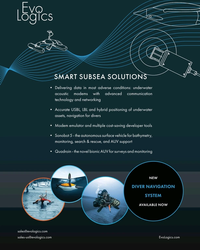 )
March 2024 - Marine Technology Reporter page: 2nd Cover
)
March 2024 - Marine Technology Reporter page: 2nd CoverSMART SUBSEA SOLUTIONS • Delivering data in most adverse conditions: underwater acoustic modems with advanced communication technology and networking • Accurate USBL, LBL and hybrid positioning of underwater assets, navigation for divers • Modem emulator and multiple cost-saving developer tools • Sonobot
-
 )
April 2024 - Maritime Reporter and Engineering News page: 43
)
April 2024 - Maritime Reporter and Engineering News page: 43“The industry is an ecosystem which includes owners, managers, mariners, shipyards, equipment makers, designers, research institutes and class societies: all of them are crucial,” – Eero Lehtovaara, Head of Regulatory & Public Affairs, ABB Marine & Ports All images courtesy ABB Marine and Ports provi
-
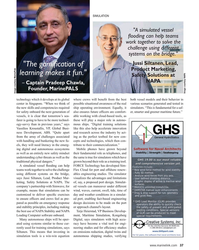 )
April 2024 - Maritime Reporter and Engineering News page: 37
)
April 2024 - Maritime Reporter and Engineering News page: 37simulations, says neering studies and for ef? ciency studies Siltanen. This means that investing in on emissions reduction, digital twins and simulation tools is a win-win equation autonomous shipping studies, verifying www.marinelink.com 37 MR #4 (34-44).indd 37 4/5/2024 8:46:54 A
-
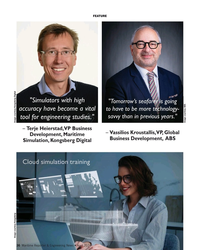 )
April 2024 - Maritime Reporter and Engineering News page: 36
)
April 2024 - Maritime Reporter and Engineering News page: 36studies." Image courtesy ABS – Terje Heierstad, VP Business – Vassilios Kroustallis, VP, Global Development, Maritime Business Development, ABS Simulation, Kongsberg Digital Clou u u ud d d d d d d s si im mu ul lati io on n n n n t t training g Image courtesy Kongsberg Image courtesy Kongsberg Digital 36
-
 )
April 2024 - Maritime Reporter and Engineering News page: 35
)
April 2024 - Maritime Reporter and Engineering News page: 35SIMULATION e have a close relationship with tech- Realism is prized beyond immersive, photo-realistic visu- nology, evidenced by, for example, als, and providers are introducing increasingly accurate func- the phones we are estimated to un- tionality. FORCE Technology’s upcoming DEN-Mark2 math- lock around
-
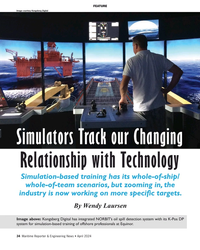 )
April 2024 - Maritime Reporter and Engineering News page: 34
)
April 2024 - Maritime Reporter and Engineering News page: 34FEATURE Image courtesy Kongsberg Digital Simulators Track our Changing Relationship with Technology Simulation-based training has its whole-of-ship/ whole-of-team scenarios, but zooming in, the industry is now working on more speci? c targets. By Wendy Laursen Image above: Kongsberg Digital has integrated
-
 )
April 2024 - Maritime Reporter and Engineering News page: 15
)
April 2024 - Maritime Reporter and Engineering News page: 15hydro-acoustic design of a propulsor that delays cavitation meets its underwater noise limits. This will require specialized inception and cavitating area. The third approach should be test sites or specialized mobile underwater testing equipment. isolation mounting of a vibro-active equipment and
-
 )
April 2024 - Maritime Reporter and Engineering News page: 14
)
April 2024 - Maritime Reporter and Engineering News page: 14Book Review Approach to Meeting Underwater Radiated Noise Limits Def ned By Raymond Fischer uantitative underwater radiated noise limits will construction inspections, 5) possible training with respect to be developed shortly by IMO, and/or countries salient design/construction essentials, 6) compliance
-
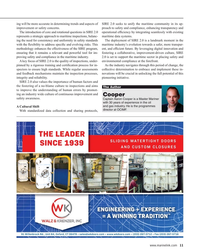 )
April 2024 - Maritime Reporter and Engineering News page: 11
)
April 2024 - Maritime Reporter and Engineering News page: 11ing will be more accurate in determining trends and aspects of SIRE 2.0 seeks to unify the maritime community in its ap- improvement or safety concerns. proach to safety and compliance, enhancing transparency and The introduction of core and rotational questions in SIRE 2.0 operational ef? ciency by
-
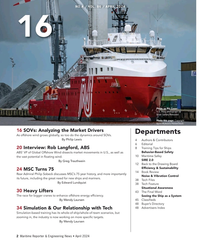 )
April 2024 - Maritime Reporter and Engineering News page: 2
)
April 2024 - Maritime Reporter and Engineering News page: 2to enhance offshore energy ef? ciency. Seeing the Ship as a System By Wendy Laursen 45 Classi? eds 48 Buyer’s Directory 48 Advertisers Index 34 Simulation & Our Relationship with Tech Simulation-based training has its whole-of-ship/whole-of-team scenarios, but zooming in, the industry is now working
-
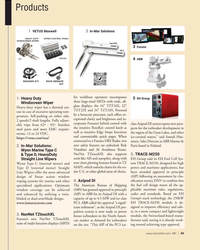 )
April 2024 - Marine News page: 43
)
April 2024 - Marine News page: 43Products 1 2 VETUS Maxwell In-Mar Solutions 3 Furuno ABB 4 for workboat operators encompasses EH Group 1. Heavy Duty 5 three large-sized MFDs with wide, all- Windscreen Wiper glass displays: the 16” TZT16X, 22” Heavy-duty wiper has a thermal cut- TZT22X and 24” TZT24X. Powered out in
-
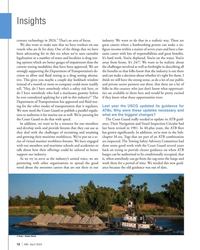 )
April 2024 - Marine News page: 12
)
April 2024 - Marine News page: 12Insights century technology in 2024.” That’s an area of focus. industry. We want to do that in a realistic way. These are We also want to make sure that we have workers on our great careers where a hardworking person can make a six- vessels who are ? t for duty. One of the things that we have ? gure
-
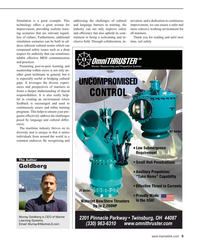 )
February 2024 - Maritime Reporter and Engineering News page: 9
)
February 2024 - Maritime Reporter and Engineering News page: 9Simulation is a great example. This addressing the challenges of cultural novation, and a dedication to continuous technology offers a great avenue for and language barriers in training, the improvement, we can ensure a safer and improvement, providing realistic train- industry can not only improve
-
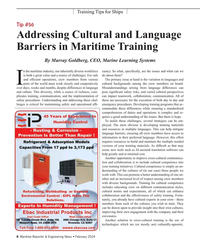 )
February 2024 - Maritime Reporter and Engineering News page: 8
)
February 2024 - Maritime Reporter and Engineering News page: 8Training Tips for Ships Tip #56 Addressing Cultural and Language Barriers in Maritime Training By Murray Goldberg, CEO, Marine Learning Systems n the maritime industry, our inherently diverse workforce ciency. So what, speci? cally, are the issues and what can we is both a great value and a source of
-
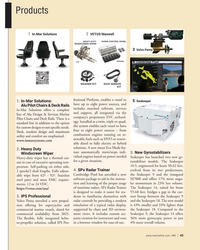 )
February 2024 - Marine News page: 43
)
February 2024 - Marine News page: 43Volvo Penta unveiled a new propul- radar controls by providing a modern and the Seakeeper 18. The new model sion offering for superyachts and simulation of a typical radar display, is 43% smaller and 33% lighter than commercial marine vessels, slated for supported by chart and 3D environ- the Seakeeper
-
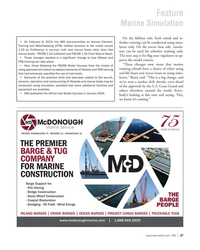 )
February 2024 - Marine News page: 37
)
February 2024 - Marine News page: 37Feature Marine Simulation On the lifeboat side, both initial and re- • On February 9, 2023, the IMO sub-committee on Human Element, fresher training can be conducted using simu- Training and Watchkeeping (HTW) rati? ed revisions to the model course lators only. On the rescue boat side, simula- 1.23 on
-
 )
February 2024 - Marine News page: 36
)
February 2024 - Marine News page: 36Feature Marine Simulation Pioneering regulatory change Without simulation, opportunities to train on marine evacuation systems are few and far between, basically only Virtual Marine’s impact extends beyond technology de- coming along when the system becomes outdated and velopment. The company has played
-
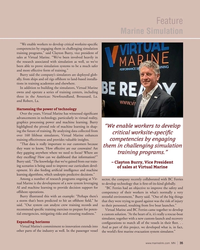 )
February 2024 - Marine News page: 35
)
February 2024 - Marine News page: 35Feature Marine Simulation “We enable workers to develop critical worksite-speci? c competencies by engaging them in challenging simulation training programs,” said Clayton Burry, vice president of sales at Virtual Marine. “We’ve been involved heavily in the research associated with simulation as well
-
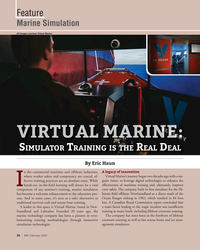 )
February 2024 - Marine News page: 34
)
February 2024 - Marine News page: 34Feature Marine Simulation All images courtesy Virtual Marine S T R DIMULATOR RAINING IS THE EAL EAL By Eric Haun A legacy of innovation n the commercial maritime and offshore industries, where worker safety and competency are crucial, ef- Virtual Marine’s journey began two decades ago with a sin- fect
-
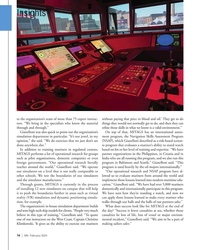 )
February 2024 - Marine News page: 14
)
February 2024 - Marine News page: 14in what we know is a valid environment.” Gianelloni was also quick to point out the organization’s On top of that, MITAGS has an international assess- simulation department in particular. “It’s our jewel, in my ment program, the Navigation Skills Assessment Program opinion,” she said. “We do exercises that
-
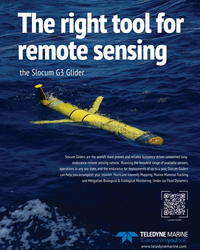 )
January 2024 - Marine Technology Reporter page: 4th Cover
)
January 2024 - Marine Technology Reporter page: 4th CoverThe right tool for remote sensing the Slocum G3 Glider Slocum Gliders are the world’s most proven and reliable buoyancy-driven unmanned long- endurance remote sensing vehicle. Boasting the broadest range of available sensors, operations in any sea state, and the endurance for deployments of up to a year
